Kite Surfing Boots: Gear for Peak Performance
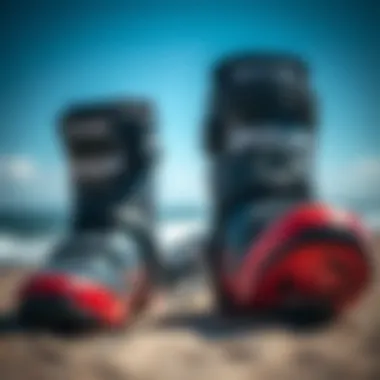
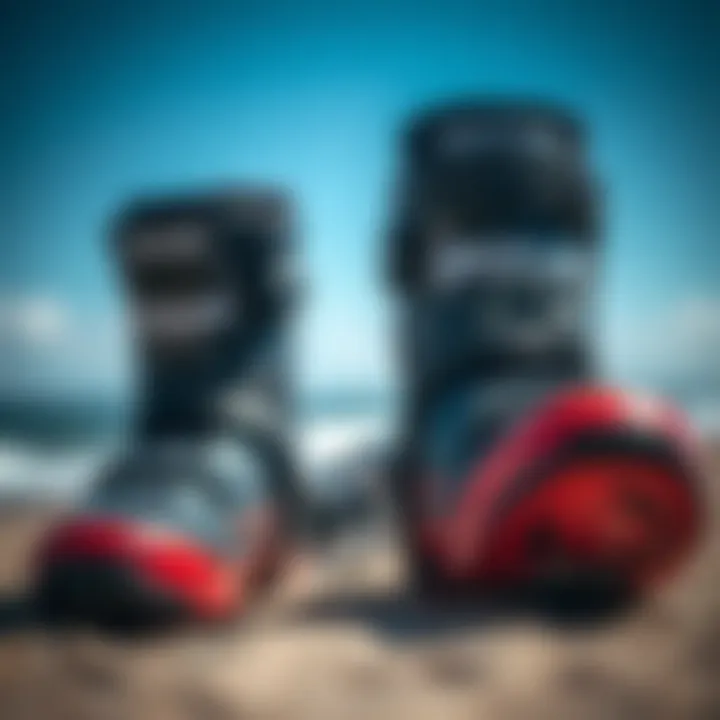
Intro
Kite surfing, a thrilling blend of adventure and athleticism, relies heavily on the right gear for both performance and safety. Among this gear, kite surfing boots play an often overlooked yet pivotal role. They are not merely a complement to your outfit, but a cornerstone in your kiteboarding experience. With various materials, designs, and features on the market, selecting the right pair can make the difference between an exhilarating ride and a frustrating day on the water.
Understanding the nuances of kite surfing boots requires a detailed look into their construction, compatibility with different boards, and how they interact with diverse riding styles. Moreover, maintenance also factors into your overall performance and enjoyment of the sport. This guide aims to illuminate these aspects and offer kiteboarders—be they beginners or seasoned pros—insight into choosing the ideal boots for their needs.
As we unravel the sections ahead, we'll delve into specific types of boots available, the construction materials that affect flexibility and control, and how to align your choices with your personal riding style. We will also touch upon safety practices and valuable training techniques to enhance your skill set. By the end, you should feel well-equipped to navigate the waters with confidence, knowing your feet are supported every step of the way.
Preamble to Kite Surfing Boots
Kite surfing is not just a sport; it’s an exhilarating blend of skill and adrenaline. Being well-equipped can mean the difference between a thrilling ride and an uncomfortable outing at sea. One piece of equipment that often gets overlooked is the kite surfing boot. These boots serve as the bridge between the rider and the board, playing a crucial role in performance and safety. In this article, we will explore the myriad aspects of kite surfing boots, from their types and features to maintenance and compatibility with various boards.
Defining Kite Surfing Boots
Kite surfing boots are specialized footwear designed specifically for kiteboarding. Unlike standard water shoes, they provide enhanced support and grip while also protecting the ankles and feet during navigation through water and potentially rough conditions. These boots typically feature a snug fit, which allows the rider to have precise control over the board. Whether you’re shredding through waves or cruising across smooth water, having the right pair of boots can significantly affect maneuverability and comfort. They are not merely accessories; they are vital components of a kiteboarder's gear that ensure that riders can maximize their performance and enjoyment on the water.
Importance of Proper Footwear
The right footwear can make or break your kite surfing experience, and there are several reasons why. Manufacturers specifically engineer kite surfing boots to provide joint stability, foot support, and insulation from cold water and impacts, which can be crucial during high-intensity rides. Here are some key benefits of investing in proper kite surfing boots:
- Foot Support and Injury Prevention: Boots offer necessary support for your feet and ankles, minimizing the risk of sprains or strains.
- Enhanced Comfort: A good pair of boots provides cushioning and thermal insulation, keeping feet cozy even in chilly waters.
- Improved Control: A snug fit ensures that your feet are firmly attached to the board, allowing for better control during jumps and turns.
- Grip: The specialized soles of kite surfing boots are designed to grip the board remarkably well, ensuring that you won’t slip during aggressive maneuvers.
Selecting the right kite surfing boots isn't just about comfort; it contributes to overall performance. An ill-fitting boot can lead to blisters or cramps, which not only detracts from your experience but can also be dangerous. Both beginners and seasoned pros need to weigh these considerations when choosing their gear to ensure a safe and thrilling kiteboarding experience.
"The footprints of a successful kiteboarding experience begin with the right boots, setting the stage for a fun and safe adventure on the water."
As we continue this exploration into kite surfing boots, we'll dive into the vast variety of options available, allowing readers to make informed choices tailored to their riding styles and preferences.
Types of Kite Surfing Boots
When it comes to kite surfing, the right boots can make a world of difference. Choosing the proper type of boot is not merely a matter of personal preference; it can significantly impact performance, comfort, and safety on the water. Understanding the various types of kite surfing boots available is essential for every kiteboarder. Let's dive into the key distinctions and benefits of different boot styles, ensuring you’re fully equipped to make an informed decision.
High-Top vs. Low-Top Boots
High-top and low-top kite surfing boots serve different purposes, and your choice between them can affect your overall riding experience. High-top boots provide more ankle support, making them ideal for riders who value stability on choppy waters or who are just starting out. This added support can reduce the risk of injuries, allowing you to focus entirely on your technique.
On the flip side, low-top boots tend to offer a greater range of motion. If freedom of movement is what you seek, perhaps for tricks or agility in your riding, then low-tops could be the way to go. However, keep in mind that they generally provide less cushioning and protection. A lower boot might not be nearly as forgiving when it comes to hard landings or rocky shores.
"Choosing between high-top and low-top boots is not just about style; it's about how you plan to ride."
Strap-In vs. Velcro Closure Systems
Closure systems in kite surfing boots also delineate the professional. Strap-in systems typically offer a tighter, more secure fit. This ensures that your foot won't slide around inside the boot while you’re carving waves or jumping, giving you the confidence to push your limits. They tend to be easier to adjust in the water, quickly allowing you to secure your gear for immediate action.
Conversely, velcro systems provide a more customizable fit but can be trickier. They may come loose with constant movement, particularly if they get wet. Conversely, if you're concerned about ease and speed when you're tackling the waves, you might find strap-ins more to your liking.
Waterproof vs. Breathable Materials
The choice between waterproof and breathable materials is pivotal in maintaining comfort during your kite surfing sessions. Waterproof materials keep your feet dry, which can be priceless during longer rides or in colder conditions. A good waterproof boot can help regulate your body temperature, keeping you warm and preventing hypothermia if you’re out for an extended time or if you take an unexpected plunge.
Breathable materials, on the other hand, are excellent for warmer days. They allow moisture to escape, helping to prevent sweat buildup, which can lead to discomfort and even blisters. This is especially valuable for those who tend to ride for hours on end under the hot sun. Consider your local climate and personal preference, as choosing the right material can significantly impact your overall experience on the water.
Features to Consider When Choosing Boots
Choosing the right kite surfing boots is pivotal not just for your comfort but also for your performance on the water. The right footwear can enhance connection with your board, improve control, and minimize the risk of injury. This section dives into the essential features you should keep in mind to ensure your boots deliver the best possible experience.
Foot Support and Comfort
When it comes to foot support, one cannot underestimate its significance in kite surfing. Proper support helps maintain balance and reduces the fatigue one experiences during long sessions. A good pair of boots should cradle your foot, providing a snug yet comfortable fit that feels like a second skin. Look for features like arch support and cushioned footbeds, which can significantly improve comfort levels. Without adequate support, an exhilarating ride can quickly turn uncomfortable, leading to short sessions on the water.
Key Aspects of Foot Support:
- Arch Support: Boots with built-in arch support can help distribute weight evenly.
- Cushioning: Look for models with memory foam or gel padding. They'll absorb shocks from landings or rough waters.
- Ankle Support: Reinforced ankle areas provide stability, particularly for aggressive maneuvers.
"If your feet ain't happy, ain't nobody happy!"
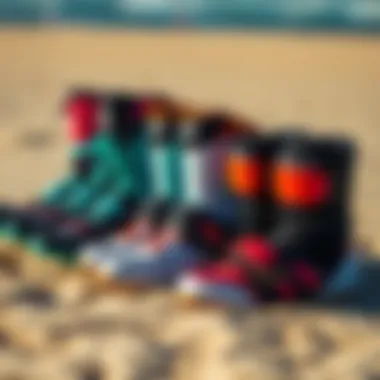
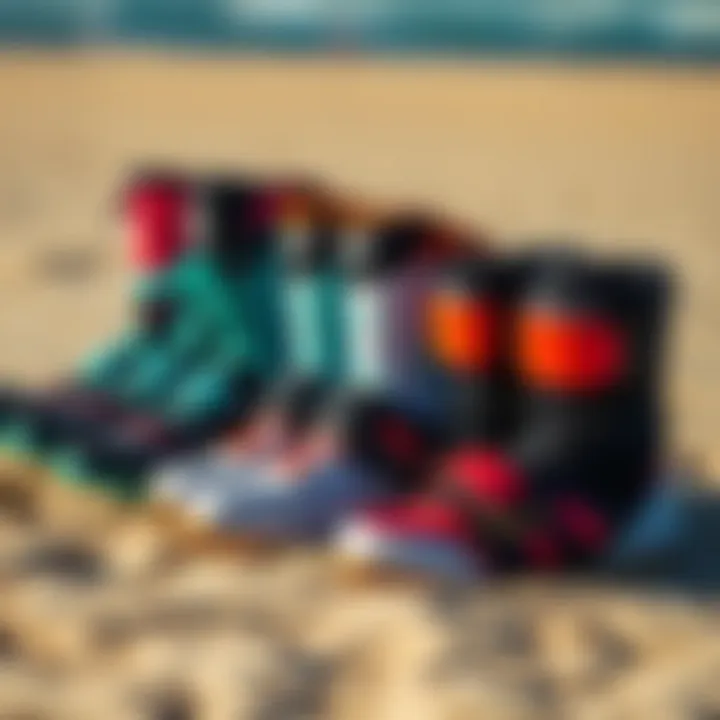
Traction and Grip
Next on the list is traction, which should never be overlooked. Traction surfaces on the boot soles should be designed specifically to grip the board. A well-designed sole enhances your control during powerful maneuvers. Whether you’re tackling big waves or gusty winds, good grip can be your best friend. Look out for materials like rubber that provide heat resistance and superior grip, ensuring you stay glued to your kiteboarding board even during extreme conditions.
Features Impacting Traction:
- Material Composition: Select boots that use a durable rubber blend suitable for wet surfaces.
- Sole Pattern: Check for soles with a textured surface or patterns that provide maximum grip.
- Compatibility: Ensure the traction of the boots works harmoniously with your board's bindings and surface.
Flexibility vs. Stiffness
Finding the right balance between flexibility and stiffness can be a bit of a tightrope walk. Flexible boots provide greater freedom of movement, allowing for a natural foot position. On the other hand, stiffer boots enhance control and responsiveness. So, what's the answer? It often depends on your proficiency and riding style. Beginners may opt for more flexible options, which allow easier maneuvering. As you advance, you might seek stiffer boots that give you the precision needed for complex tricks.
Pros and Cons:
- Flexible Boots:
- Stiff Boots:
- Pros: Better immediate comfort, enhanced natural foot movement.
- Cons: May lack responsiveness and control.
- Pros: Increased board control and precision.
- Cons: Can feel restrictive and less comfortable, especially for new riders.
Size and Fit Precision
The saying "one size fits all" doesn’t apply in the world of kite surfing boots. A precise fit is essential; boots that are too tight cause discomfort and can actually hinder performance. On the flip side, loose-fitting boots may lead to slipping, reducing your control. Always take the time to measure your foot and refer to the manufacturer's size chart before purchasing. Some brands also offer half sizes or adjustments for a more tailor-made fit.
Considerations for Size and Fit:
- Foot Shape: Different brands cater to different foot shapes. Check which brand fits you best.
- Try Before Buying: If possible, wear the boots for a while and see how they feel after some movement.
- Thickness of Socks: Consider the thickness of socks you plan to wear. A boot that feels perfect without socks can feel tight with them.
Compatible Board Types
Understanding the right type of kite surfing boot to pair with your board is crucial for maximizing performance and ensuring safety on the water. The right compatibility can mean the difference between a great ride and a frustrating experience. Different board designs require different attachment systems, and choosing boots that complement your board’s specifications will enhance your overall kiteboarding experience.
Bindings vs. Boot Systems
When it comes to selecting your kite surfing gear, the debate often comes down to bindings versus boot systems. Bindings, which are typically more common in traditional kiteboarding setups, offer riders a flexible option that allows for quick adjustments and easy entry and exit. They can be suitable for those who prefer a looser feel while maneuvering through the waves, allowing for some foot movement within the board.
On the flip side, boot systems provide a more snug fit around the foot and lower leg, resulting in excellent control during high-speed maneuvers. These systems use a closed-toe design and often feature innovative closure mechanisms for secure fitment. Many experienced riders favor boots as they provide direct connection with the board, translating movements with greater precision.
"Choosing the right attachment system is like picking the right tool for the job. Not all boards are created equal, and neither are the rider's preferences."
Here are some pros and cons of both systems:
- Bindings
- Boot Systems
- Pros:
- Cons:
- Easy to get in and out of
- Versatile and adjustable
- More room for foot movement
- Less control during extreme maneuvers
- May require re-adjustments
- Pros:
- Cons:
- Excellent control and responsiveness
- Locking mechanism enhances safety
- A snug fit can improve performance
- Harder to get in and out of
- Might be less versatile for different styles
Ultimately, the choice between bindings and boot systems should align with your riding style, board type, and level of experience. It’s wise to experiment with both types if possible to discover which system feels right for your personal comfort.
Choosing Boot-Compatible Boards
When selecting a kite surfing board, ensuring that it is compatible with your chosen boot system enhances both safety and performance. Not all boards are built the same; some come with specific footbed designs while others may be more standard, affecting how bindings or boots fit.
Key factors to keep in mind include:
- Board Type: Explore different board types such as twin tips, directional boards, or foil boards, and their specific requirements for attachments.
- Footbed Design: Check whether the board features pads or footbeds that align well with the foot structure of your boots.
- Riding Style: Your style also dictates what board type suits you best. Freestyle will differ from wave riding conditions, influencing boot and board compatibility.
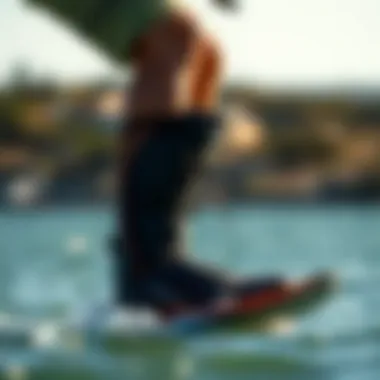
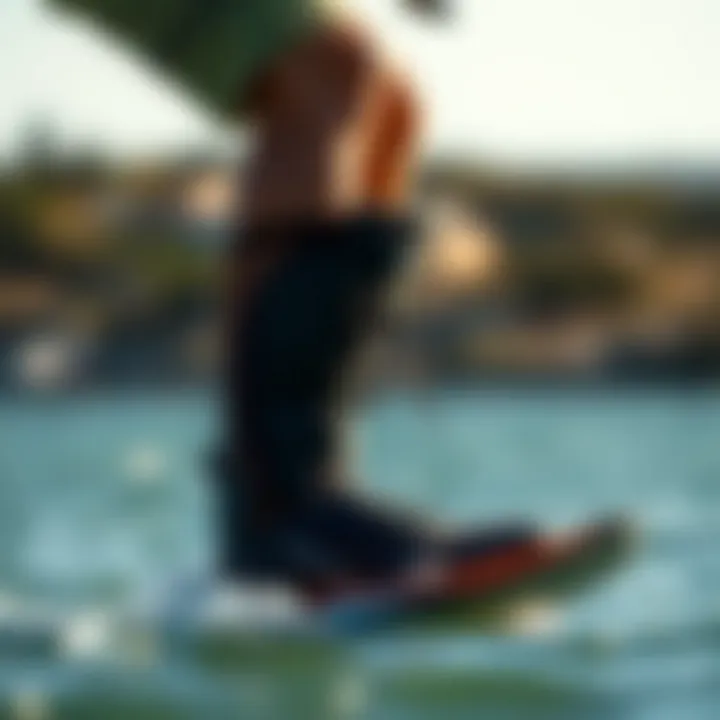
Before making a purchase, examining manufacturers’ guidelines can save you from eventual headaches. Certain brands end up collaborating on design, making it easier to find compatible systems. Also, personal preferences cannot be overstated; a comfortable fit is critical for performance.
In summary, the significance of matching your kite surfing boots with the correct board type is not to be overlooked. Engaging with the right combo will allow you to harness the full potential of your kiteboarding adventures and elevate your overall experience on the water.
For more detailed insights, consider visiting sites like Wikipedia or forums such as Reddit where you can gather opinions from fellow kiteboarders.
Boot Maintenance and Care
Taking care of kite surfing boots is crucial for prolonging their life and ensuring optimal performance on the water. Boots receive a fair bit of punishment from the elements: saltwater, sand, and the general roughness of kiteboarding. Therefore, a proper maintenance routine not only extends their lifespan but also maintains comfort and efficiency during rides. Regular care minimizes the risk of injuries that can arise from poorly maintained footwear.
Cleaning and Drying Techniques
The first step in maintaining kite surfing boots is a solid cleaning regimen. After every session, rinse the boots with fresh water. This simple act helps to remove salt, sand, or any unwanted debris that may have accumulated. If you skip cleaning, it can lead to a buildup of substances that may degrade materials over time. A soft brush can be handy for scrubbing off stubborn dirt without damaging the surface.
Drying is just as important. After rinsing, leave them out to air dry. Avoid direct sunlight as it can warp the materials and cause fading. Placing them upside down in a ventilated area works wonders. If the interior is damp, consider using newspaper or a dedicated boot dryer to absorb moisture effectively.
"Proper care ensures that your gear won’t just perform but thrive on the water."
Storage Recommendations
When your kite surfing boots have seen enough waves for the day, it’s essential to store them correctly. Avoid cramming them into a tight bag which can cause them to lose shape. Instead, consider using an open tote or a designated space in your gear closet. Keeping them organized preserves their structure.
Temperature plays a big role as well. Store them in a cool, dry place, away from direct heat sources. Heat can warp the materials and mess with the fit. Additionally, consider inserting boot trees or soft fillers to help them maintain their shape when not in use.
Things to consider for storage:
- Avoid stacking heavy items on top of boots.
- Ensure they're completely dry before putting them away.
- Keep them away from sharp objects that could cause punctures.
Inspecting for Wear and Tear
Even with proper care, it's important to regularly check your kite surfing boots for signs of wear and tear. This includes inspecting the soles for any missing tread, checking the closure systems for functionality, and ensuring the materials are holding up well. Addressing small issues early can prevent them from becoming bigger, more costly fixes.
Key areas to routinely inspect:
- Soles: Look for any worn-down tread that might reduce grip.
- Straps/Velcro: Ensure that they still secure tightly and effectively.
- Seams and stitching: Make sure nothing is beginning to unravel.
Notice any cracks, tears, or unusual odors? These can be indicators that it may be time for a replacement. Maintaining a careful eye on your boots helps keep your kiteboarding experience safe and enjoyable.
User Profiles: Selecting Boots Based on Skill Level
Choosing the right kite surfing boots depends heavily on the rider's skill level. The footwear plays a critical role in maximizing performance, comfort, and safety on the water. Each user profile brings unique needs and preferences to the table, and understanding these can significantly enhance one's kiteboarding experience.
Beginners: Essential Features to Seek
For those just beginning their kite surfing journey, selecting the right boots can make a world of difference. Novice riders should prioritize comfort and ease of use above all else. It's essential to look for boots that offer:
- Good Padding: Extra cushioning can help soften those inevitable falls while learning.
- Easy Entry Systems: A user-friendly entry system is vital; consider Velcro straps that can be adjusted with one hand.
- Stability: A boot with adequate ankle support helps maintain control as one learns basic techniques.
- Size Flexibility: Some boots have adjustable features, allowing for growth as riders develop their skills.
Searching for these key features, beginners can build confidence while reducing the risk of injury. They will appreciate the difference between cumbersome footwear and those designed with ease in mind.
Intermediate Riders: Balancing Comfort and Performance
Once kiteboarders have acquired some experience, their needs shift. Intermediate riders often seek a balance between comfort and performance elements. Here's what this group should consider:
- Responsive Fit: Look for boots that mold to the foot without being too tight. An ideal boot offers stability without sacrificing comfort.
- Enhanced Traction: As one starts to experiment with various maneuvers, grip becomes increasingly important. Boots featuring advanced sole materials provide improved traction on the board.
- Flex Options: It's beneficial to choose boots that offer a medium flex. This flexibility allows for freedom of movement during tricks while maintaining enough stiffness for controlled riding.
Intermediate riders are beginning to refine their skills, and their footwear should complement their riding style, enhancing their overall performance.
Advanced Riders: High-End Options
For the seasoned kite surf enthusiasts, high-end boots are worth every penny spent. Experienced riders often desire the perfect blend of performance, durability, and technology in their footwear choices. When selecting boots at this level, consider the following elements:
- Material Technology: Boots utilizing cutting-edge materials like lightweight carbon fiber or innovative neoprene can enhance performance by reducing drag and increasing responsiveness.
- Customizable Features: Advanced options often come with customizable insoles or heel pads to tailor fit and support to specific needs.
- Durability: High-quality boots should withstand the wear and tear from the sea. Look for reinforced seams and wear-resistant materials.
- Riding Style Adaptation: Boots that cater to specific riding styles, whether it's freestyle or wave riding, can drastically improve performance.
Riders who take their sport seriously will appreciate high-end boots for their advanced features that cater directly to their performance and aesthetic preferences.


"The right gear often separates the good riders from the great riders, especially in extreme sports."
Each segment of kite surf enthusiasts has distinct footwear requirements. By understanding how skill level influences boot selection, riders can enhance their experience on the water, boosting their confidence and honing their techniques.
Evaluating Performance: Testing and Feedback
Understanding how to evaluate the performance of kite surfing boots is crucial for any rider, from the eager novice to the seasoned pro. This section examines the importance of performance evaluation, focusing on how thorough testing and obtaining feedback can significantly influence your choice of the right gear.
When kiteboarding, the right footwear can make a world of difference. Light weight, comfort in the toughest conditions, and a good grip are key factors that riders must never overlook. Many don't realize it initially, but poorly-performing boots can lead to a lack of control, making what should be an exhilarating experience turn into a frustrating struggle. This underlines the necessity of testing and gathering feedback on kite surfing boots before making a final purchasing decision.
Look for Key Performance Indicators
In the world of kite surfing, understanding what to look for in a boot is paramount. Here are some essential performance indicators that should guide your evaluation:
- Comfort Level: One of the most important aspects is how boots feel during use. Look for boots that fit snugly without pinching. A good test is to wear them for an extended period.
- Water Drainage: Quality boots should have effective water drainage to prevent heavy waterlogging during your ride. This maintains buoyancy and adds to the overall experience.
- Grip and Traction: The less slipping you have on your board, the more control you possess. Inspect the sole for adequate grip patterns that enhance traction.
- Flexibility: Depending on your style, you’ll want boots that allow some flex and movement for tricks or those that provide solid support for speed runs.
- Durability: Boots take a beating, so materials that withstand wear and tear are vital. Check user feedback regarding the longevity of particular models.
Each of these elements contributes to not just a rider’s performance but also their safety. If a boot fails in any of these areas, particularly grip or comfort, it can lead to injuries or reduced performance.
User Reviews: Prioritizing Insights
Gaining insights from other riders presents invaluable information that might not be apparent from product descriptions alone. User reviews provide a real-world glimpse into how boots perform under various conditions. Here are some things to keep in mind when assessing reviews:
- Authenticity: Look for reviews from verified purchasers. Reviews from real users are often more trustworthy than manufacturer claims.
- Adaptability to Different Conditions: Feedback on how boots perform in different weather and water conditions is crucial. Look for mentions of performance in choppy seas or during strong winds.
- Rider Style: A beginner may prefer cushioning and ease-of-use over precision, while an advanced rider might seek high-end materials for agility. Knowing the reviewer’s skill level can help frame their feedback in a way that resonates with your own needs.
- Points of Concern: Pay attention to common complaints. If multiple users mention issues with comfort or durability, those factors should weigh heavily in your decision-making process.
"When you listen to other users, you are not just buying a product; you are investing in an experience. Their insights can navigate you through your choices, helping you avoid pitfalls that they have faced."
By synthesizing these key performance indicators with user reviews, kite surfers can make more informed decisions. Ultimately, testing and feedback are not just part of the purchasing process but are integral to enhancing your entire kiteboarding experience.
Current Trends in Kite Surfing Boots
In recent years, the kite surfing community has seen an impressive evolution in gear technology, particularly when it comes to boots. Recognizing the direct correlation between performance and the equipment used has led brands to be innovative. Riders today demand not only functionality but also durability and style. Given this, being in-the-know about current trends in kite surfing boots has become crucial for any kiteboarder, ranging from the novices to the seasoned pros.
Innovative Materials and Technologies
The landscape of kite surfing boots is currently undergoing a significant overhaul thanks to cutting-edge materials and technologies. Modern advancements have enabled brands to create boots that are lighter, more durable, and offer better performance on the water. For instance, carbon fiber reinforcements are becoming a standard feature, enhancing both strength and responsiveness without adding unnecessary weight.
Besides that, thermoformable liners can be molded to the wearer’s feet, providing a custom fit that locks in comfort. Another notable trend is the use of advanced rubber compounds for the soles, that maximize grip on the board while still allowing for flexibility in movement.
"Innovation in material technology not only enhances performance but also significantly extends the life of your gear, ensuring that your investment pays off in the long run."
Furthermore, brands are opting for quick-drying nylon and neoprene composites that withstand the elements well. This incorporation of new materials translates into lighter boots that dry faster, which is certainly advantageous for those who are not keen on soggy wet gear.
Sustainability Trends in Gear Production
As environmental awareness continues to rise, the kite surfing industry is also focusing on sustainability in gear production. Many manufacturers are making concerted efforts toward eco-friendly practices. This trend isn’t merely a fleeting idea; brands are increasingly mindful of the impact their production has on the environment.
For example, several companies are now utilizing recycled materials in their boot construction. This approach is not just beneficial for the planet; it reflects positively on the brand’s image, thereby resonating with eco-conscious consumers. Bamboo and organic cotton are being introduced for softer linings, giving a more sustainable option while still promising comfort.
Moreover, water-based adhesives and non-toxic dyes are gaining popularity. These substances reduce the harmful chemicals released during the manufacturing process, creating a safer workspace for employees and a healthier product for consumers. The increasing demand for these sustainable products signals that kiteboarders care about their gear as much as they care about the ocean.
Adapting these sustainable practices has not only yielded environmental benefits but has appealed to a growing base of customers who value sustainability as an essential aspect of their purchasing decisions.
In summary, as we look into the current trends, kite surfing boots are not just about keeping feet secure and supported anymore. They are becoming symbols of innovation and sustainability, and understanding these elements will help riders make better-informed choices as they navigate through the ever-evolving world of kiteboarding gear.
Finale: The Future of Kite Surfing Boots
In the ever-evolving landscape of kiteboarding, the significance of kite surfing boots cannot be overstated. As technology progresses and kiteboarding becomes more popular, boots are set to undergo a transformation that enhances both performance and safety for riders at all levels. To truly optimize the kiteboarding experience, it's essential to stay informed about these advancements and how they can impact the way we ride.
Preparing for New Developments
The kite surfing boot market is on the brink of numerous developments. These boots are crafted with new materials that promise greater durability and lighter weights. Manufacturers are experimenting with the application of temperature-regulating fabrics and responsive cushioning systems. Such features aim to provide unparalleled comfort and support, especially for those long sessions on the water.
Considering the growing emphasis on sustainability, innovations will also likely include eco-friendly materials that don’t compromise on performance. Riders should be proactive and follow emerging trends, keeping an eye on product releases and industry news. Participating in forums such as reddit.com or local community events can provide insight into what the future holds for gear.
Emphasizing Functional Design for Enhanced Experience
Functional design is at the heart of any successful kite surfing boot. As gear design evolves, it's important to remember that boots must prioritize performance without sacrificing comfort. New models will likely integrate specific features like improved footbed ergonomics, which cater to various foot shapes.
Additionally, the weight of the boots plays a crucial role. Lighter boots without sacrificing durability allow for better maneuverability on the water, essential for advanced techniques and lengthy sessions. It’s not just about looking good on the beach; the functionality of these boots can greatly impact your ride.
By focusing on functional designs that respond to the dynamic needs of kiteboarders, manufacturers can ensure that participants enjoy a better experience. The ultimate aim is to create boots that feel like an extension of the rider’s body, enabling flawless execution of maneuvers and providing the confidence needed to push personal limits in kiteboarding.
As the world of kite surfing progresses, those who adapt and embrace new technologies will undoubtedly remain at the forefront of this exhilarating sport.



